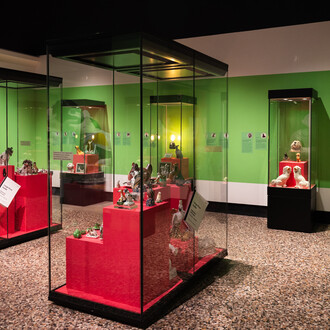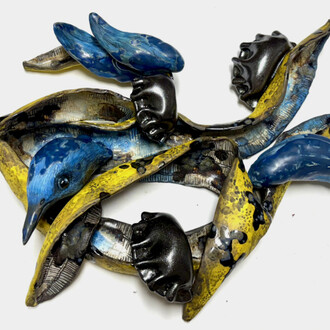This exhibition – which is accompanied by an extensive publication – presents two centuries of Franco-German relations in architecture and urban development. Based on new, bilateral research it is a joint project by the Musée d’art moderne et contemporain de Strasbourg and Deutsches Architekturmuseum in Frankfurt/Main.
Since 1800, architectural doctrines, structures and urbanist visions have repeatedly also been the focal point of differences of opinion between Germany and France. The exhibition highlights various debates and polemics in a number of stages, beginning with the Napoleonic era, continuing through the industrial age and Modernism, and concluding with present-day united Europe. The show documents the changing passions of the protagonists in both countries, which oscillate between curiosity and admiration, nationalistic confrontation, dialog, and cooperation.
Particular attention is paid to show the mutual influence of the cities – such as Paris and Berlin – as well as on the situation in the border regions. These were formed by annexations and occupations – e.g. in the cases of Strasbourg, Metz, the Rhineland, and the Saar. The flow of ideas is reconstructed, designs and visions that made their way across the border are documented, and also the stream of architects and urban planners, who moved as scouts, missionaries and agents in both directions – a number of times interrupted by the war.
Interference not only reminds us of the ones that made sure that the building cultures of the two countries clashed and interactions came about. The exhibition also documents the changing passions of the actors between curiosity, admiration, confrontation, rivalry, dialogue and cooperation.
The exhibition is divided into nine sections. With Cologne, Mainz, Karlsruhe, Stuttgart, Saarbrücken, Kassel, Wiesbaden, Berlin, Strasbourg, Metz, Thionville, Lyon, Reims, Marseille, Paris, and other places and landscapes, these sections have not only the historical rooms of the two countries in view. Beginning with the French Revolution and its transformations they go through the architecture of the industrial and the modern era over two centuries and result in the presence of a united Europe.
Interferenzen presents original drawings and plans, documents and models. Works by J. W. Goethe, Eustache de Saint-Far, Friedrich Gilly, K. F. Schinkel, Friedrich Weinbrenner, Leo von Klenze, Gottfried Semper, Victor Hugo, Viollet-Le-Duc, Fernand Léger, Marcel Gromaire, Peter Behrens, Le Corbusier, Ernst Ludwig Kirchner, Walter Gropius, Albert Speer, Paul Schmitthenner, Ernst Neufert, Rudolf Schwarz, Georges Candilis, Rob Krier, Josef Paul Kleihues und Thomas Bayrle, and many other architects and artists will be on display.
Deutsches Architekturmuseum (DAM)
Schaumainkai, 43
Frankfurt am Main 60596 Deutschland
Ph. +49 069 212 38844
info.dam@stadt-frankfurt.de
www.dam-online.de
Opening hours
Tuesday, Thursday - Sunday
From 11am to 6pm
Wednesday from 11am to 8pm
Related images
- 1, 2 & 3 Die Ausstellung im DAM, © Uwe Dettmar
- 4 Albert Speer, Das Deutsche Haus auf der Weltfachausstellung in Paris (1937), Nachtaufnahme mit Feuerwerk vor dem Eiffelturm, 1937
- 5 Eckhard Schulze-Fielitz, Raumstadt, 1959, Foto: Philippe Magnon, © Collection fonds régional d’art contemporain du Centre, Orléans
- 6 Eugène Beaudouin, Marcel Lods, Jean Prouvé, Cité de la Muette, Drancy, 1931–1935, Foto: Marcel Lods, © Académie d’architecture, Cité de l’architecture et du patrimoine, Archives d’architecture du XXe siècle, Fonds Lods, Paris














